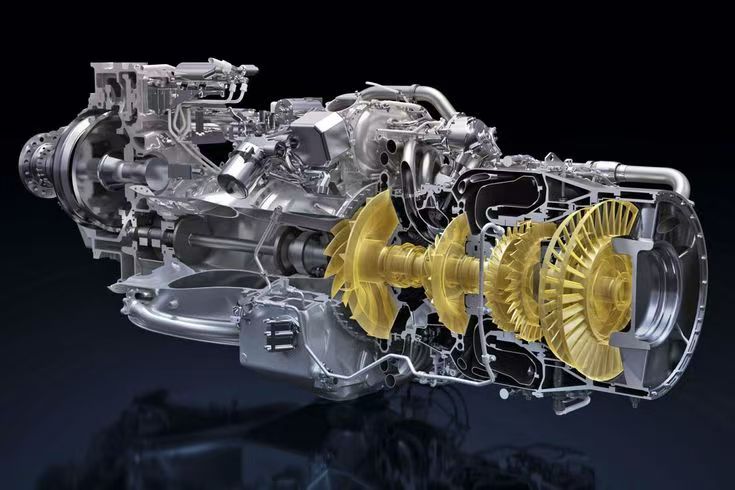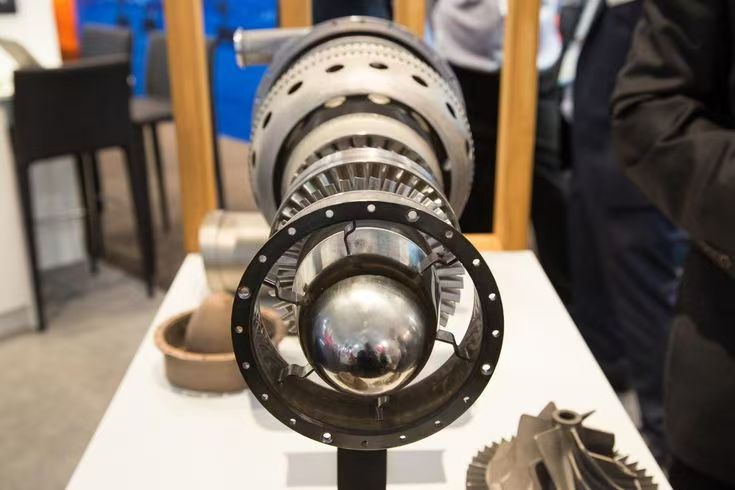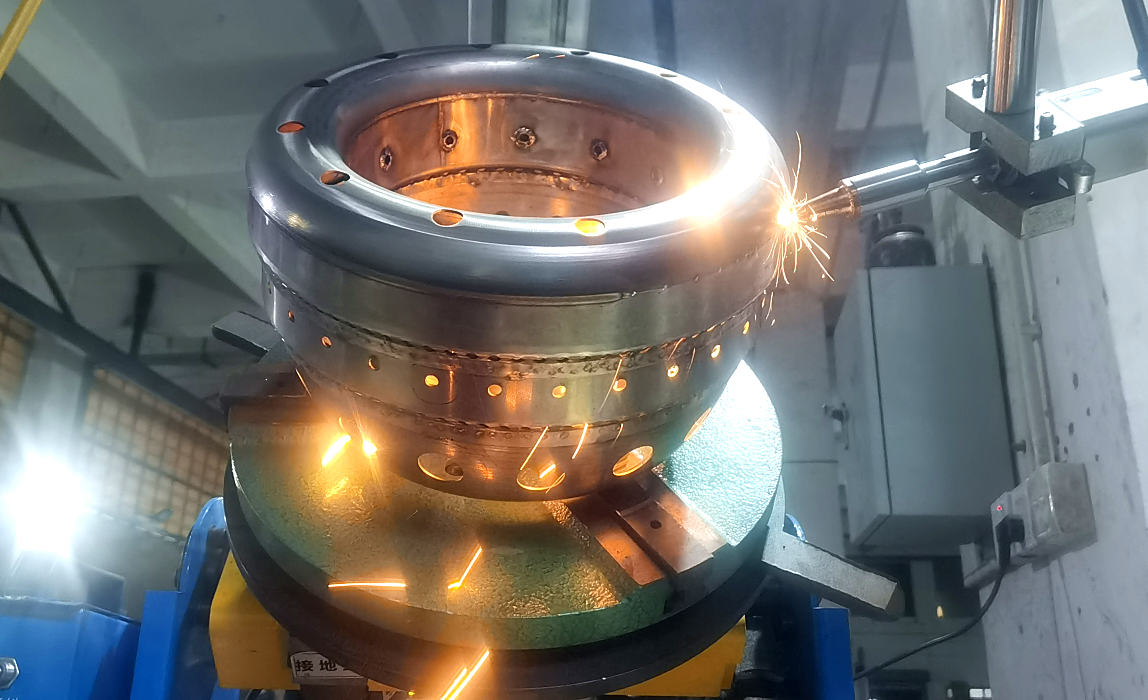
Combustion chamber
- size :
270
- thickness:
2
- material:
310
- application:
Unmanned aerial vehicle
What is combustion chamber
The combustion chamber is the core component of an engine. The working principle of the combustion chamber is to convert chemical energy into thermal energy through the mixed combustion of fuel and air, thereby driving mechanical work or generating high-temperature and high-pressure gas.
Application
1. Gas turbine Engine (Aviation/Industry)

● Position : between the compressor and the turbine.
● Function : The heated gas flow drives the turbine to rotate, suitable for aero engines or industrial gas turbines.
● Structural composition : including flame tube, fuel nozzle, ignition device, etc., to ensure stable combustion.
2. Multi-stage combustion systems (such as incinerators)

● The second-stage combustion chamber : further burns the incompletely discharged exhaust gas, raises the temperature and reduces pollutant emissions (such as SOx, NOx)
● Application : industrial waste gas treatment or waste incineration field.
Material
1. Nickel-based superalloy (Mainstream Choice)
① GH4163
● Advantages: Yield strength ≥800 MPa at 800℃, excellent oxidation resistance and fatigue resistance, suitable for combustion chamber load-bearing parts
● Process: γ "phase strengthening is achieved through solution treatment + aging treatment, balancing high-temperature strength and microstructure stability
② GH3230
● Advantages: Short-term strength at 1050℃ ≥400 MPa, outstanding resistance to thermal corrosion, suitable for the cylinder of the afterburner
● Feature: The Cr₂O₃ self-healing oxide film can still effectively prevent gas erosion at 1000℃
2. Iron-nickel-based Alloys (Economical Solution)
Hastelloy X
● Features: Good oxidation resistance at 1200℃, excellent welding performance, suitable for medium-temperature combustion chamber structural components.
● Application: Gas turbine combustion chamber and hot end protection components.
3. Carbon composite Materials (Frontier Technology)
● Characteristics: Density < 2.0g /cm³, retains strength above 1650℃, requires anti-oxidation coating protection.
● Application: F119 engine tail nozzle and other ultra-high temperature components.
Material Selection suggestions
● High-temperature zone (>800℃) : nickel-based alloys such as GH4163 or GH3230 are preferred
● Medium temperature range (600-800 ° C) : consider Hastelloy X or 2.4816 alloy
● Ultra-high temperature/lightweight requirements : carbon/carbon composite materials combined with coating technology
Spinning performance
Because the combustion chamber operates in a high-temperature environment, the tensile strength, yield strength and hardness of the high-temperature alloys used are all higher than those of the commonly used stainless steel 304. Moreover, the ductility of these alloys is much worse than that of 304. Cold-rolled high-temperature alloy materials are prone to cracking and require a large rotational force. So when spinning high-temperature alloys, heating is always required. The heating methods include high-frequency and propane. When using high-frequency heating, a custom-made copper ring is required, which is rather troublesome during experiments. A convenient method is to use propane for heating. The heat generated by propane heating is higher than that of gas, and the heating is more uniform and faster.
Tolerance control
High-temperature alloys are prone to thermal expansion in the die and cutter wheel during hot spinning, which affects the final spinning accuracy and dimensions. In addition, the heating time and temperature control of the working components are also very important.
● Mold and roller : The mold and the knife wheel are continuously produced for a period of time and then cooled for a period of time, And apply lubricating oil to the roller that wears out very quickly at high temperature.
● Infrared temperature gun : Using it to detect the temperature of the workpiece.
● No-go gauge : It is used to test the accuracy of spun metal products.
Why the aerospace and aviation part made by spin forming
The materials used in aerospace and aviation are all special metals. Besides the price is expensive, they also have excellent mechanical properties. Traditional processing costs are high. CNC turning processing belongs to cutting processing. Although there is no mold cost, the material utilization rate is particularly low. The material utilization rate of normal aviation parts lathes is 30-50%. However, the spinning forming process basically has no cutting or loss. The material utilization rate is as high as 80-90%. The cost of deep drawing dies is high, being 3 to 5 times that of spinning dies. Additionally, the modification of deep drawing dies is complex, while spinning dies can be directly adjusted on machines through turning.
Most aviation materials are relatively hard and have poor formability. Spinning can reduce the hardness and tensile strength of the material by heating and increase its ductility, which is difficult to achieve through other processing methods. Most importantly, after the material undergoes spinning, grain refinement occurs, and the tensile strength and hardness of the blank will be enhanced. In the aerospace field, weight control is mostly required. Under the same wall thickness conditions, the mechanical comprehensive performance of spun products is more outstanding.
Why you choose the wrong supplier
Many combustion chamber design engineers have taken many detours when looking for suppliers because most spinning companies do not have the conditions to produce combustion chambers. Many factories produce spinning products for consumer goods such as lighting fixtures, tableware, and hotel crafts. They are not familiar with the metal materials of aviation parts and cannot control the precision and wall thickness of the products, resulting in the inability to assemble and weld the final parts.
It is difficult to make a combustion chamber

1. Not only metal spinning
One part of the combustion chamber is spun, and the other components also need to be turned, milled, wire-cut, five-axis machining, electrical discharge machining and welded. The precision of parts requires a reasonable arrangement of process steps in order to effectively control the final precision of the product.
2. Reasonable fixture design
The parts of the combustion chamber are relatively thin. When CNC turning and milling are required, if a reasonable fixture support is not designed, the product processing will generate vibration, thereby affecting the surface finish and accuracy of the product.
3. Precision 5-Axis laser cutting
The repeat positioning accuracy of most five-axis laser cutting machines is not high. To better control the relative position accuracy of the hole positions, the repeat positioning accuracy of five-axis laser cutting needs to reach 0.1mm. In addition, five-axis laser cutting is not as stable as plat laser cutting. When cutting very small circular holes that diameter is less than 2mm, the cutting edge is prone to generating waves.
4. Welding fixture and automatic welding
The design of welding fixtures is very crucial for assembly. How to ensure assembly accuracy before welding and control internal stress deformation after welding is important to the functionality of the final product.
● The welding gap
The welding gap is required to control within 0.1mm, If the gap between the two workpieces being welded is uneven, it will cause different welding stresses. Uneven stress can cause the product to deform after welding.

● Welding ways
Laser welding and argon arc welding are the most commonly used welding methods. The advantage of laser welding is that the heat generated during welding is small, the weld seam is small, and the welding stress deformation is less. Therefore, laser welding has obvious advantages in thin metal welding. Argon arc welding has a greater heat input and greater welding deformation, and has more advantages in thick metal welding. No matter which welding method is used, when full welding is achieved, automatic welding should be adopted to reduce the unevenness of heat input throughout the radial direction.
Why choose Dinnovation metal spinning>
● Excellent metal spinning technology
● Advanced CNC metal spinning machine
● Perfect welding fixture and quality control .






